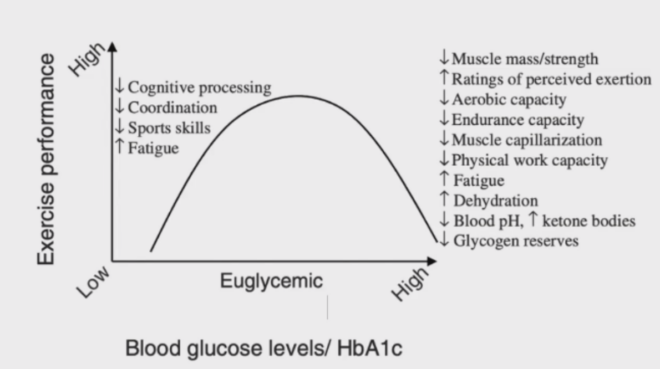Experts Share: The Challenges of Exercise with Type 1 Diabetes + Tips for Making it Easier
Session: Ask the Experts: Management of the Athlete with Diabetes
Presentations: Physiology, Metabolism, and Training Behaviors of the Competitive Athlete Living with Type 1 Diabetes and Clinical Strategies to Support the Developing Athlete with Type 1 Diabetes
Speakers at this ADA Scientific Sessions presentation included: Michael Riddell, PhD (York University) and Lori Laffel, MD, MPH (Joslin Diabetes Center). Chaired by Stewart Harris, CM, MD, MPH, FCFP, FACPM (Western University).
Exercise is one of the most complicated aspects of diabetes and blood sugar management, especially for athletes.
A panel of experts at the 83rd Scientific Sessions, presented by the American Diabetes Association (ADA), shared the challenges athletes living with type 1 diabetes (T1D) face and the changes they can implement to improve their performance. Experts also shared tips for doctors on supporting up-and-coming athletes living with type 1 diabetes.
Exercise challenges people with type 1 diabetes face
Athletes with T1D experience frequent low blood sugars, are at risk for diabetic ketoacidosis (DKA) and can struggle to calibrate their insulin and carbohydrate levels to reach their desired health outcomes. Athletes with T1D are at higher risk for dehydration, delayed low blood sugar levels, slow injury recovery and insulin pump or continuous glucose monitor (CGM) device adhesives peeling off more quickly. Diabetes devices can even interfere with exercise sometimes.
When approaching exercise, people with diabetes may worry about highs and lows, cardiovascular risk or hypoglycemia unawareness.
Dr. Riddell knows how challenging exercising with type 1 diabetes is, having lived with it for 40 years. Riddell explained the mechanics of exercise with T1D to the audience, offering an empathetic view to guide the scientific explanation.
Dr. Riddell’s tips for enabling blood sugar predictability with exercise included:
- If your exercise intensity is above 80% VO2 max and your insulin on board (IOB) is low, you’re more likely to have high blood sugar.
- If your exercise intensity is below 80% VO2 max and your IOB is high, you’re more likely to have low blood sugar.
Unpredictability makes exercise recommendations complex
Dr. Laffel added that for people with T1D, there is no predictable blood sugar response to exercise, and people with diabetes all take individual approaches. For example, some people may not want to eat more carbohydrates to exercise, but others may approach it oppositely.
Each body’s unique response to exercise makes recommending blood sugar management techniques to athletes with T1D complex because optimal blood sugar levels are individual. One athlete’s optimal blood sugar level may be too low or high for another. Whatever a person with diabetes’ method is, the common experience shared among almost all people with diabetes is the frustration around exercise.
It can be nearly impossible to determine how someone’s blood sugars will respond to exercise—some people crash during endurance exercise, while others experience a blood sugar spike.
Dr. Laffel recommended the following considerations before exercise:
- The time, duration and intensity of the activity you’re about to do (strength training usually raises blood sugar while cardio will drop it).
- How much insulin and carbohydrates you have on board.
- What your insulin regimen is (manual daily injections, insulin pump, automated insulin delivery system, etc.).
Dr. Riddell recommends correcting high blood sugar before starting exercise and bolusing in the early recovery phase. Following these recommendations can help prevent the onset of DKA. Dr. Riddell and Dr. Laffel clarified that preventing low blood sugar during exercise is a priority. For athletes, 70% time in range (TiR) is ideal for training, with less than 1% low.

Technology advances can make exercise more manageable
Technology is making exercise easier for people with T1D. The development of CGMs, faster-acting analog insulins, inhalable glucagon and hybrid closed-loop systems have enabled athletes with T1D to compete at higher levels.
People with diabetes, especially athletes, are encouraged to use wearable monitoring devices such as pedometers, heart rate and sleep monitors to track exercise. Wearing devices like this can make exercise much more manageable when used with tools like insulin pumps and CGMs.
Despite advancements, there is still a need for even faster insulins, mini-dose glucagon, more sophisticated automated insulin delivery (AID) systems and more precise CGMs to improve the quality of life for athletes with T1D.
Exercise with type 1 diabetes is still possible and encouraged despite the challenges
While exercise is crucial for everyone’s good health, it is vital for people with diabetes, Dr. Laffel shared. Exercise can help people with diabetes with weight and blood sugar management, cardiovascular, metabolic and mental health. It can also help reduce the likelihood of developing diabetes complications later in life.
According to the Centers for Disease Control and Prevention (CDC), adults should aim for at least 150 minutes of moderate or vigorous weekly activity. This guidance is equivalent to 30 minutes daily, five days per week. Aim to strength train at least two days per week, with no more than two rest days in a row.
Children should aim for at least 60 minutes of moderate or vigorous activity daily, including strength training. Guidance for children is equivalent to 420 minutes of exercise per week.





